Cows are one of the most common domesticated animals in the world today. We have many uses for cows, and these animals are often beautiful to look at.
The use of a cow depends on its breed, so the breed is the first thing to consider when looking for a cow to raise.
The following table outlines some of the breeds found around the world and their primary uses. As you can see, cattle serve different purposes depending on where they are raised.
| Breed | Origin | Color | Uses |
| Black Angus | Scotland | Black | Beef |
| Hereford | England | Dark red or red-yellow, white face | Beef |
| Red Angus | Scotland | Red | Beef |
| Charolais | France | White or creamy | Beef |
| Gelbvieh | Germany | Red | Milk and beef |
| Limousin | France | Golden-red | Beef |
| Simmental | Switzerland | Red and white | Beef |
| American Brown Swiss | United States | Pale brown | Milk and Pet |
| Highlands | Scotland | Creamy or golden | Beef |
| Texas Longhorn | United States | Multiple colors, mostly red and white | Beef and ornamental |
| Holstein | Netherlands | Black and white | Milk or breed stock |
| Santa Gertrudis | USA | Red or brown | Beef |
| Florida Cracker | USA | Multiple colors | Beef |
| Belted Galloway | Scotland | Black and white | Ornamental and beef |
| Pinewoods | Spain | Cream or white with black spots | Beef and milk |
| Red Sindhi | Pakistan | Red and brown | Milk and draft |
| Brahman | India | White and Ash | Beef |
| Beefmaster | United States | Brown or red | Beef |
| Piedmontese | Italy | Light red | Milk and beef |
| Hallikar | India | Grey or dark grey | Beef and draft |
| Watusi | Africa | Brown or red | Beef and breeding |
| Randall Lineback | England | White and black | Milk and beef |
| Shorthorn | England | Red and White | All-purpose |
| Dexter | Ireland | Black with brown tone | Milk and beef |
Cattle in the United States may not have as many purposes as in the parts of the world where they are used for farming and hauling still. However, the number of breeds found here is large. Read this easy guide to discover more about thirteen of the most common cow breeds in the US.
Table of Contents
13 Common Cow Breeds in the United States
Here are some of the most common cow breeds that people raise in the United States:
1. Black Angus
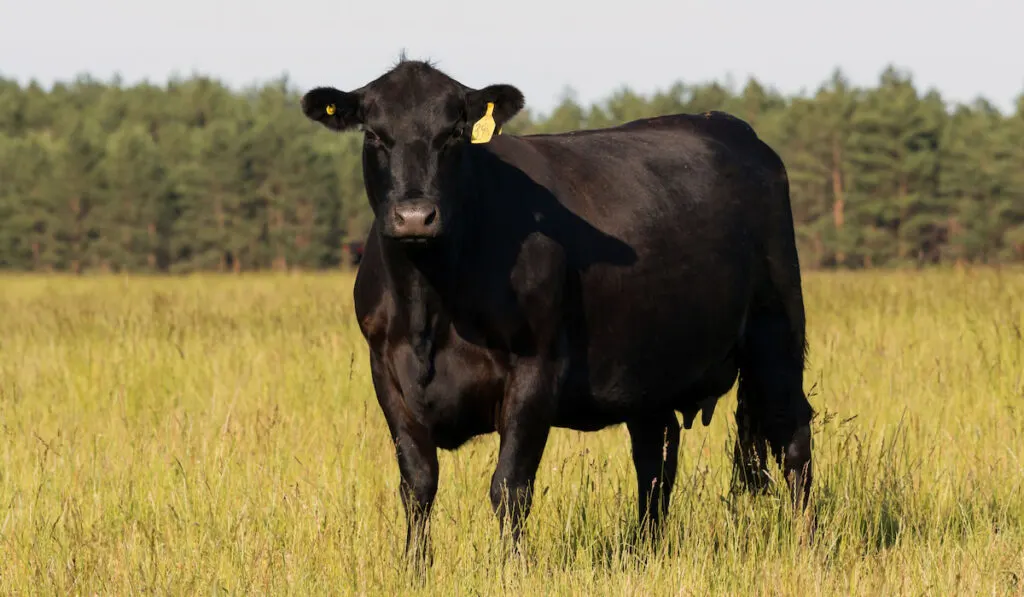
The Black Angus cow breed is the most common in the United States, with more than 333,000 registered individuals. This breed is popular because it produces flavorful beef for steaks.
- Origin: This breed is indigenous to Scotland though it has naturalized in the United States.
- Use: Its primary use is beef.
- Maintenance: Black Angus cows have a great feed conversion rate. They are less expensive to feed compared to other breeds.
- Other features: They make great mothers and have few calving complications.
This popular breed came to the United States in the 19th century.
2. Hereford
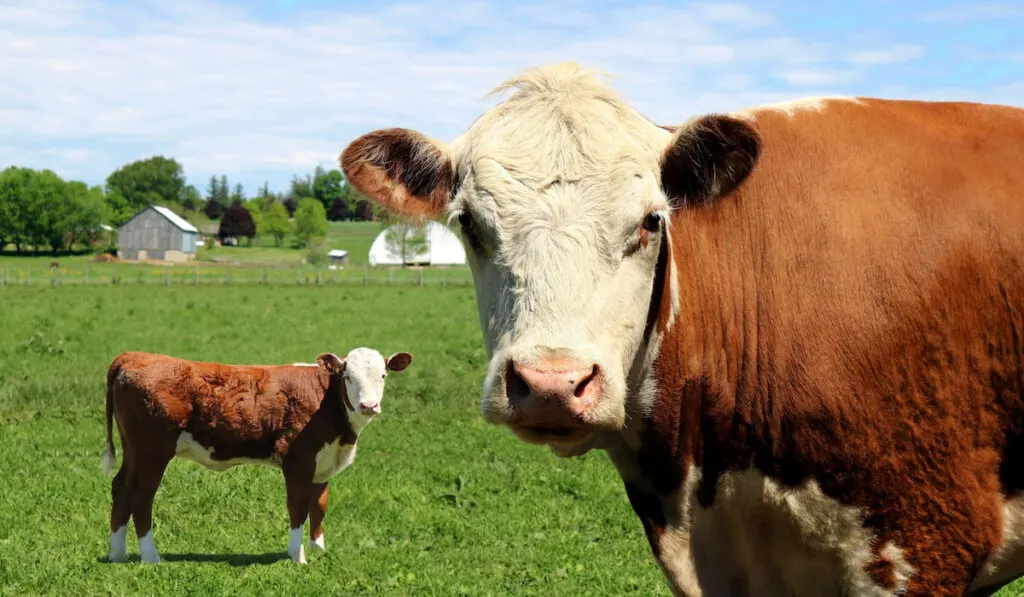
Hereford cows are English cows that are popular in the United States because they have an early maturity and can grow fast. Even though they are prized for their beef, they also produce sweet and quality milk.
- Origin: They originated and are popular in England.
- Use: They are primarily used for beef production, though they also make sweet milk.
- Maintenance: These cows are good mothers and reliable calvers. So long as they have enough food and clean water, they will grow well.
- Other features: They are prized for their longevity. Also, Herefords are very docile.
Would you not like to have this beauty?
3. Red Angus
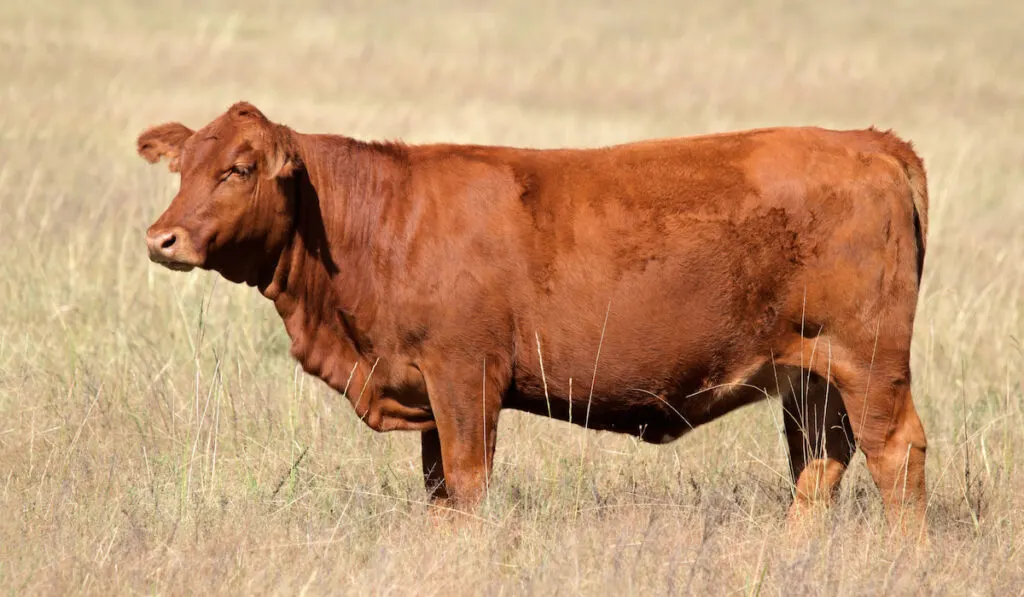
Red Angus cows are similar to but not popular as their black cousins. This breed can grow in hotter temperatures and produce flavorful beef. If you prefer red to black, this is the Angus for you.
- Origin: Just like their black cousins, Red Angus cows originate from Scotland.
- Use: They produce flavorful beef.
- Maintenance: They are easy to maintain so long as they have enough food and clean water. Allow them to graze in large fields.
- Other features: Red Angus cows are docile and gentle. As such, they can be handled by people. They also have excellent mothering skills.
Red Angus cows are very common and have been naturalized in the United States.
4. Charolais

Here is a large and heavy cow breed that will surely get your attention. This large breed can withstand the cold of winter, and you can even grow it in warmer temperatures. The primary purpose of growing this breed is to produce beef.
- Origin: Charolais cows originate from France.
- Use: Their primary purpose is beef production.
- Maintenance: You do not need to feed your cows with expensive grains as they have an excellent feed conversion rate and can grow quickly with grass or hay.
- Other features: The length of the Charolais breed coat grows according to season. The coat is fuller and thicker in winter when compared to summer.
Charolais cattle are one of the largest breeds in the world. Their imposing size makes them stand out in any pasture.
5. Gelbvieh

This is a beautiful breed originating from Germany but was introduced into the United States with artificial insemination. It has solid red pigmentation and is grown because females quickly produce offspring, and males make great breeders.
- Origin: Gelbvieh cows originate from Germany.
- Use: People grow Gelbvieh cows for beef and milk production. They also make great ornamental cows.
- Maintenance: The cows make excellent and reliable mothers. Ensure they have a shelter to protect them from extreme temperatures and rain.
- Other features: This breed is very fertile and has a fast growth rate.
Gelbvieh cattle were initially horned but have become polled due to selective breeding.
6. Limousin
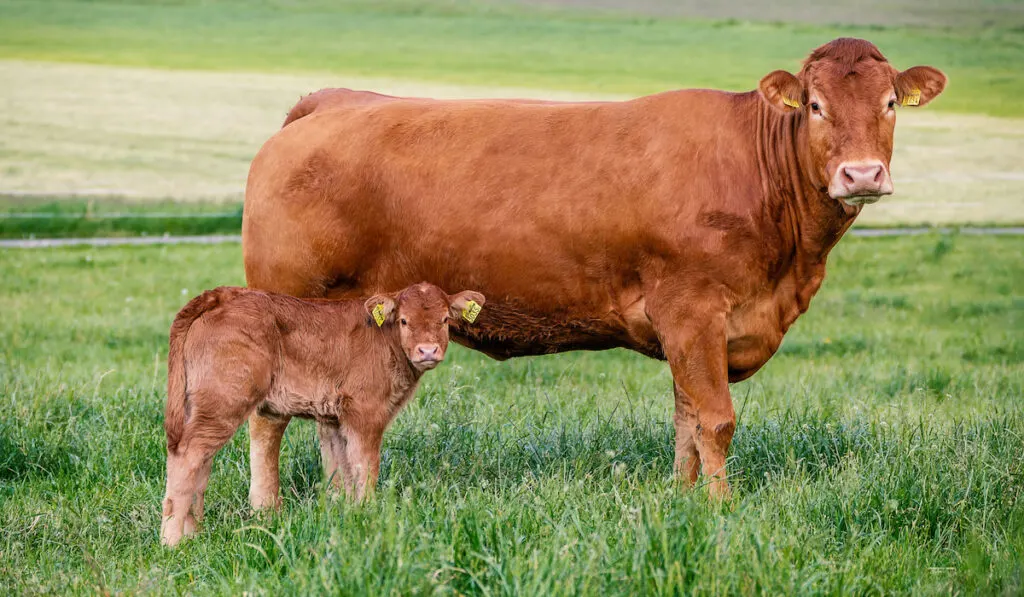
Limousin cows were initially grown in concentrations in Texas, South Dakota, and Oklahoma. However, they have expanded across North America because of their desirable features.
- Origin: This beautiful breed originates from the south-central regions of France, specifically Marche and Limousin.
- Use: Limousin cows are primarily grown for beef. They produce sweet steaks.
- Maintenance: Easy to maintain so long as you do not raise them in hot climates. Provide an insulated winter shelter.
- Other features: Although it is not the largest beef cattle, people love this breed as it is fast-growing and easy to grow.
This breed has a golden-red coat that always attracts people.
7. Simmental
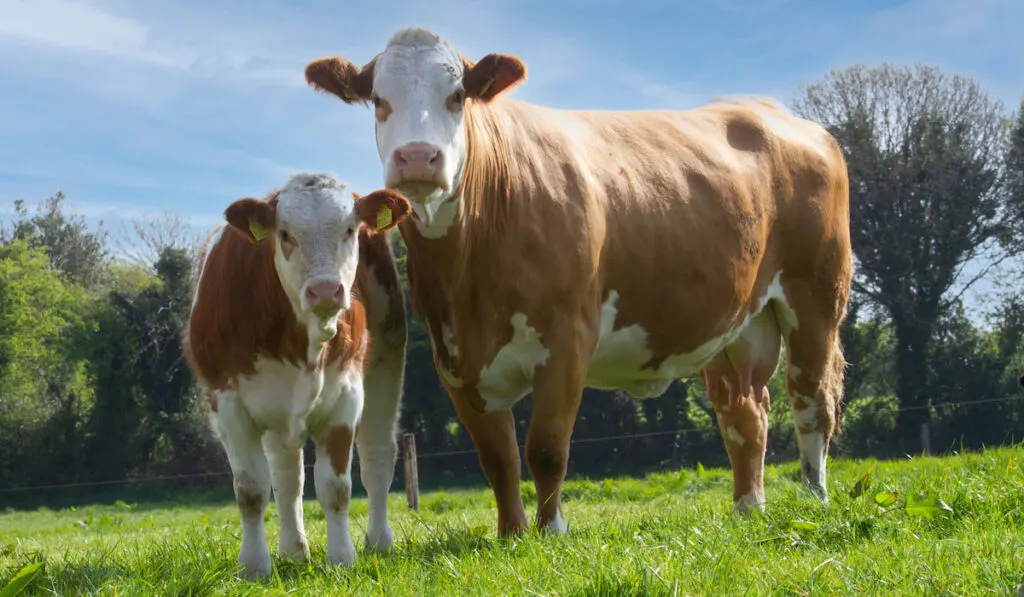
The Simmental cow breed is among the world’s oldest and most widely distributed breeds. It originates from Europe and is now found on almost every continent. Like other breeds, it is made for beef production.
- Origin: It originates from Europe, specifically Switzerland.
- Use: While it can be an ornamental breed, its primary use is beef production.
- Maintenance: It needs very little to no maintenance. This feature is what attracts farmers to the Simmental breed.
- Other features: It grows very heavy and has a large body frame.
The Simmental cow breed was introduced in the United States in the 19th century.
8. American Brown Swiss

Here is a unique cow breed that originates from the United States. This breed is an offspring of the triple-purpose Braunvieh (traditional) from the Alpine region of Europe. It is raised primarily on dairy farms today.
- Origin: It originates from the United States, though its ancestors are European.
- Use: The American Brown Swiss breed is used for milk production and as a pet.
- Maintenance: They are well adapted to living across the entire US. Just make sure that it gets quality feed and clean water.
- Other features: The males are prolific breeders. This breed is long-lived and has sound hooves and limbs.
Is this not a beautiful cow breed?
9. Highlands
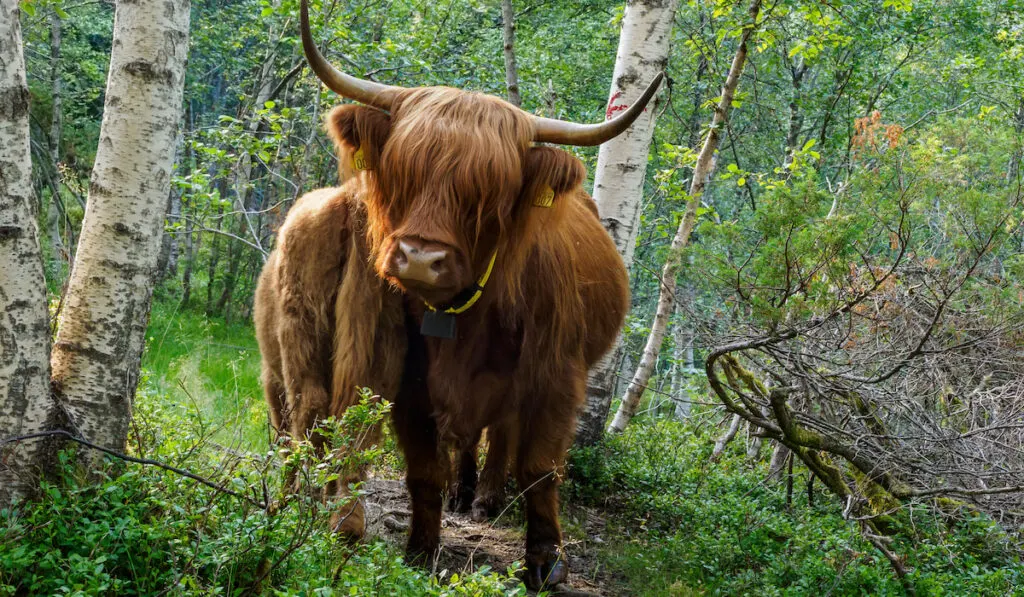
The Highlands breed is a beef breed that is great for colder regions. There is no adverse effect of cold on the cow, and it can adapt well to warmer temperatures. This breed performs better in cooler climates as its shaggy coat is too thick for hot temperatures.
- Origin: The Highlands breed originates from Scotland.
- Use: Its primary use is for beef production.
- Maintenance: It needs very little maintenance, especially in winter when other breeds need as much care as you can give. This breed rarely has eye disease, pink eye, as its eyes are covered.
- Other features: It grows a double coat (i.e., thick fur) and long horns.
You can raise this cold-hardy breed in Alaska and other cold countries.
10. Texas Longhorn
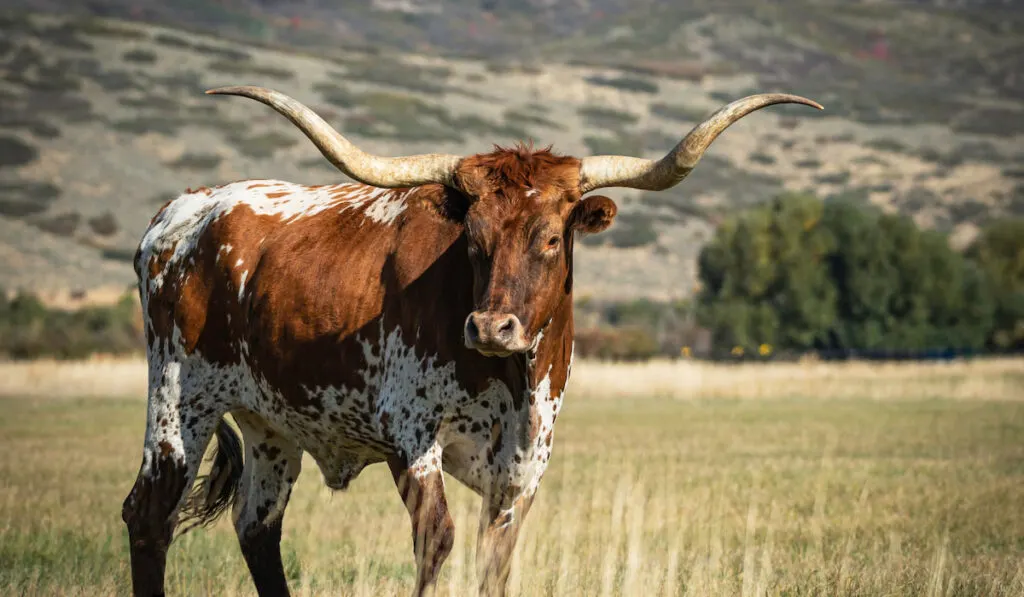
The Texas Longhorn cow breed is one of the most symbolic cows in the United States. It was brought to the US by Christopher Columbus and other colonists. It is used to remember Columbus as well as the history of Texas. It also produces sweet and quality beef.
- Origin: It originates from Spain but has naturalized well in the United States.
- Use: People raise the Texas Longhorn cow for beef and to perpetuate the history of Texas.
- Maintenance: This breed does not require a lot of care. Ensure that the cows have a large field to graze.
- Other features: It grows long horns. The horns can reach five feet long.
The symbolic horns of this breed signify that the Texas Longhorn breed is the fittest in the game of ‘survival of the fittest.’
11. Holstein
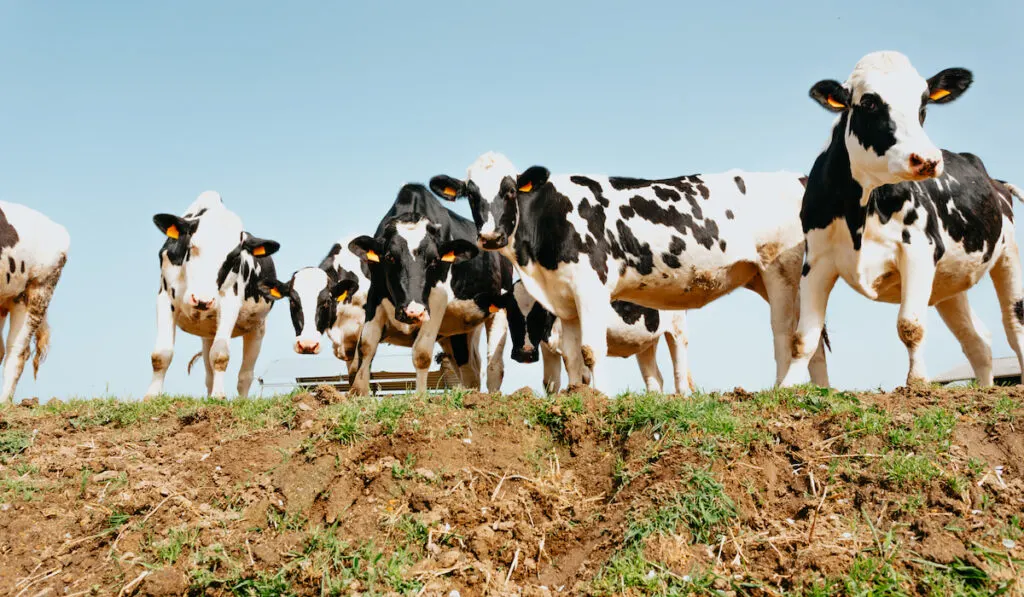
This breed is famous for its color (white and black) and its use in the dairy industry. It is prevalent in quality dairy production, and you can find it on most dairy farms in the United States.
- Origin: The Holstein breed is native to the Netherlands.
- Use: You can collect sweet milk from the breed. It is also used for breeding and beef production. It produces consistent milk and cheese.
- Maintenance: If you want more milk, you may need to provide grain supplements.
- Other features: The white and black coat is distinctive but also makes each cow unique.
This docile and easy-going cow breed requires shelter from extreme temperatures and more disease prevention than other breeds.
12. Santa Gertrudis
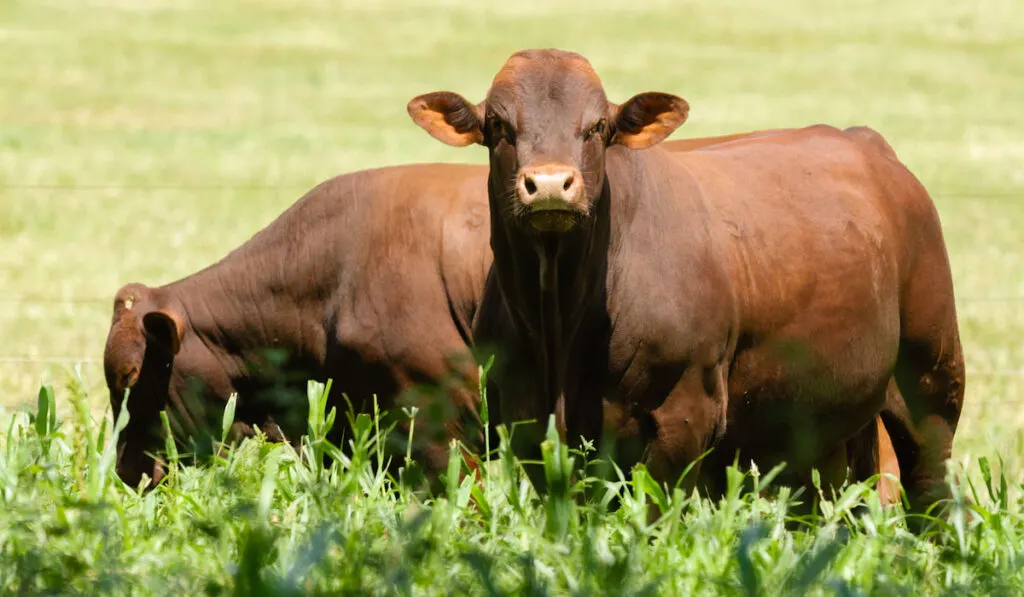
The Santa Gertrudis is a hybrid of zebu and other European cows. This red cow was born in the early twentieth century in Texas. It received official recognition in 1940 and has since spread to other parts of the United States.
- Origin: This is a unique cattle breed native to the United States.
- Use: Its primary use is to produce beef.
- Maintenance: They perform well in harsh, dry, and hot local conditions.
- Other features: According to the parents, Santa Gertrudis cows can be horned or polled.
This is a beautiful breed, don’t you think?
13. Florida Cracker

The Florida Cracker cow is a beautiful, multicolored cow named for the Florida cracker culture (in which it was kept). This breed produces sweet and quality milk but is mainly used for beef production.
- Origin: The Florida Cracker cow originates from Florida in the USA.
- Use: While it is mainly used for beef production, it also makes sweet milk.
- Maintenance: This breed is super easy to grow as it can tolerate a wide range of temperatures. Note that it prefers warmer temperatures.
- Other features: Both males and females are horned. The horns are small or moderate-sized.
This is a relatively small breed as it weighs less than 900 pounds.
Which of the breeds looks the most appealing to you?
11 Types of Other Cow Breeds (Within or Outside the United States)
There are over 1000 cow breeds recognized in the world today. It does not matter if you are in the US or not. Here are some cow breeds that you should consider:
1. Belted Galloway
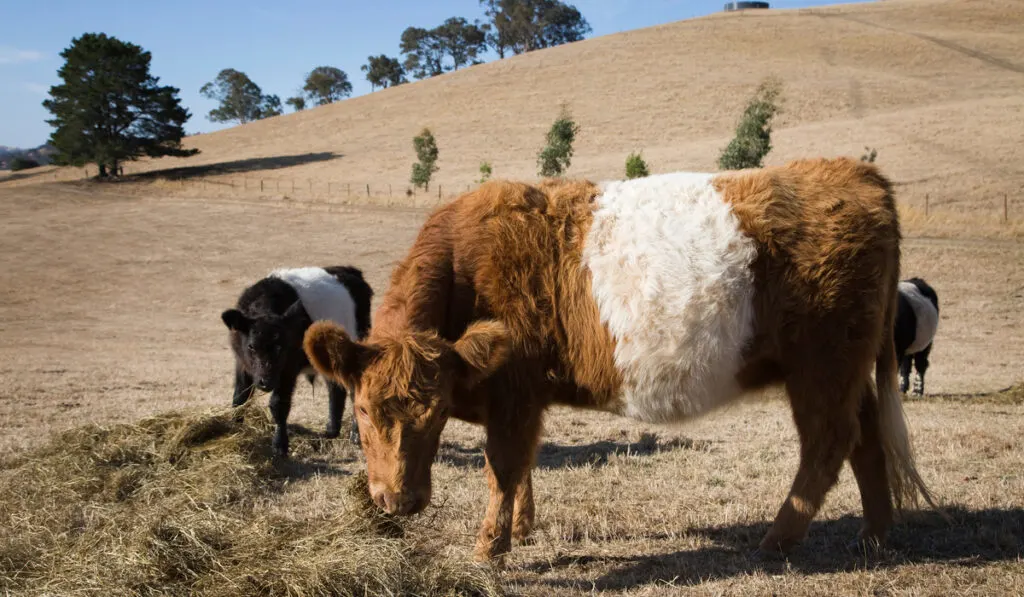
This beautiful breed is also called the Oreo cattle because of its color belt. The Belted Galloway is black or red and is characterized by its white belt on the stomach area of its body. It is a docile and common cow breed in the United States.
- Origin: The Belted Galloway breed is from Scotland though it got its belt from Dutch Belted blood.
- Use: This breed makes a beautiful ornamental cow, but it is commonly used for beef production.
- Maintenance: It is easy to maintain. Do not raise this breed in hot regions.
- Other features: It has a thick double coat to withstand lower temperatures.
The beautiful Belted Galloway breed was brought to the United States in 1950.
2. Pineywoods
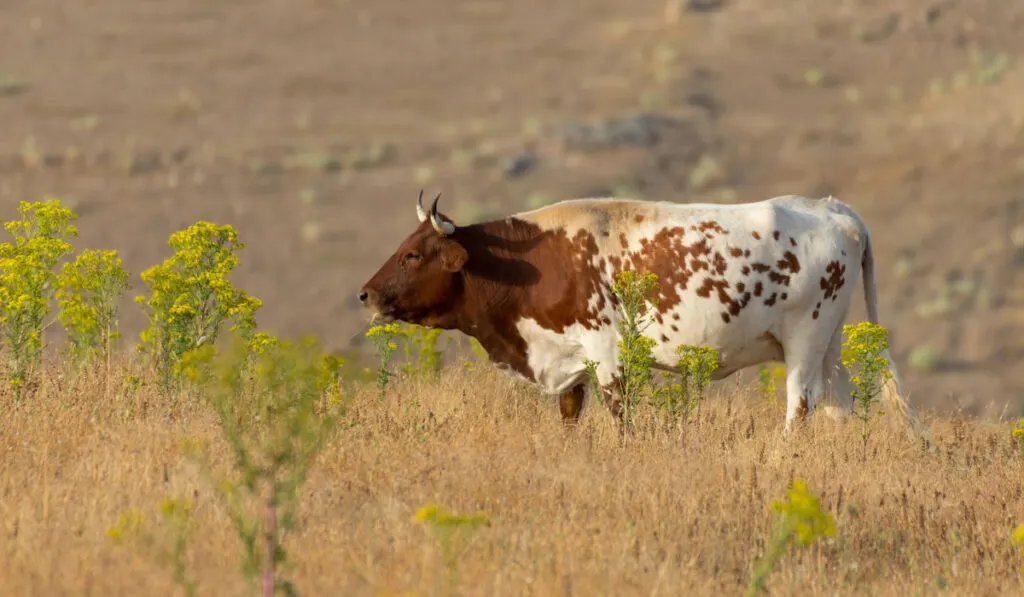
The Pineywoods cattle are a rare breed of landrace (i.e., now growing outside of its original purpose). It is one of the oldest cattle breeds in the United States. It has multi-color (solid or dotted) coats and is mainly used as dairy cattle.
- Origin: Even though it originates from Spain, it has been introduced in the United States for many years, and recent individuals can claim US origin (due to selective breeding).
- Use: Pineywoods cows are raised for beef and milk production.
- Maintenance: This breed is well-adapted to a wide range of temperatures in the United States. It is easy to grow.
- Other Features: It is horned, and the horns vary from short and crumpled to long and twisted.
The parents of the Pineywoods cow were introduced into the southeastern United States as early as the 16th century.
3. Red Sindhi (Red Karachi)
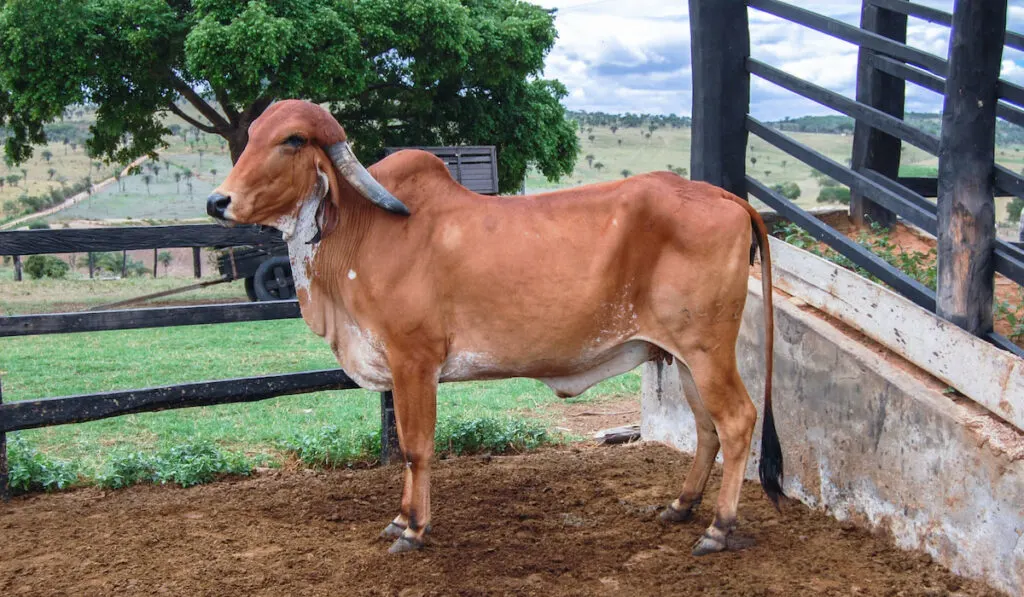
The Red Sindhi breed originates from India and Pakistan. It can be red or brown and is characterized by its very strong bones and short horns. It can grow easily in the warm parts of the United States.
- Origin: This large cattle breed originates from India and Pakistan.
- Use: It is mostly used for milk production. However, farmers also use it for some farm work.
- Maintenance: It can tolerate hot temperatures in the southern parts of the United States. It is easy to raise.
- Other features: This is a very large and strong cow breed. It is super hardy.
Even though it is not so common in the United States, the Red Sindhi breed is common worldwide.
4. Brahman
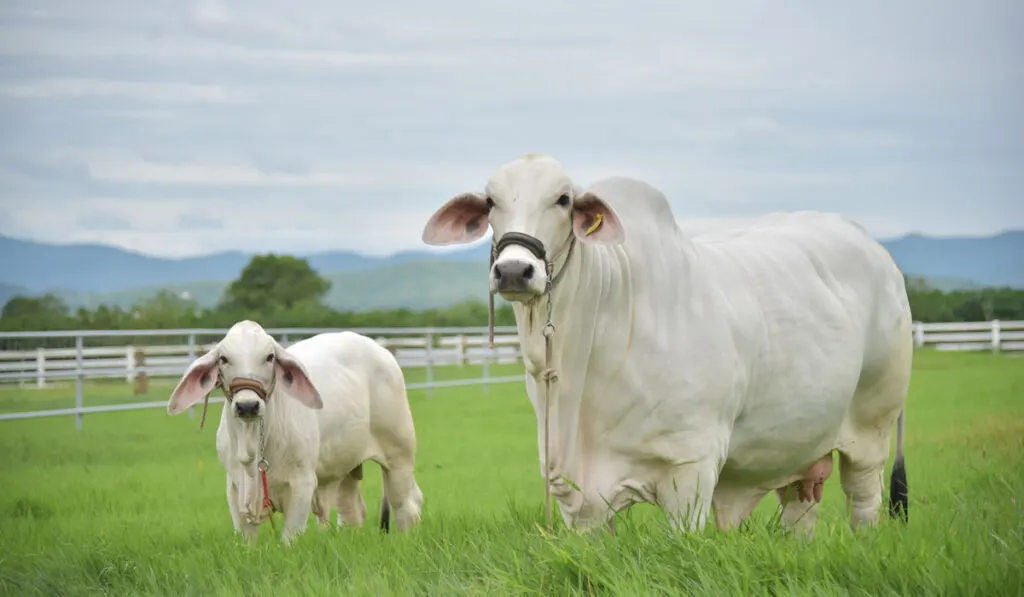
This is the most common cow breed in the world. Brahman cows are enormous and produce large humps over their shoulder and neck. They are usually white or grey with dark grey or black head and neck.
- Origin: Brahman cows are native to Asia, specifically India.
- Use: Brahman cows are the most common beef-producing cows in the world.
- Maintenance: This hardy breed can survive harsh weather and inadequate food. However, ensure that your cows are well-fed.
- Other features: They have resistance to pests, parasites, and diseases. This is a super hardy breed. Their large, drooping ears are one of their distinguishing characteristics.
Brahman cattle are very hardy and even produce oils in their sweat that repels some pests.
5. Beefmaster
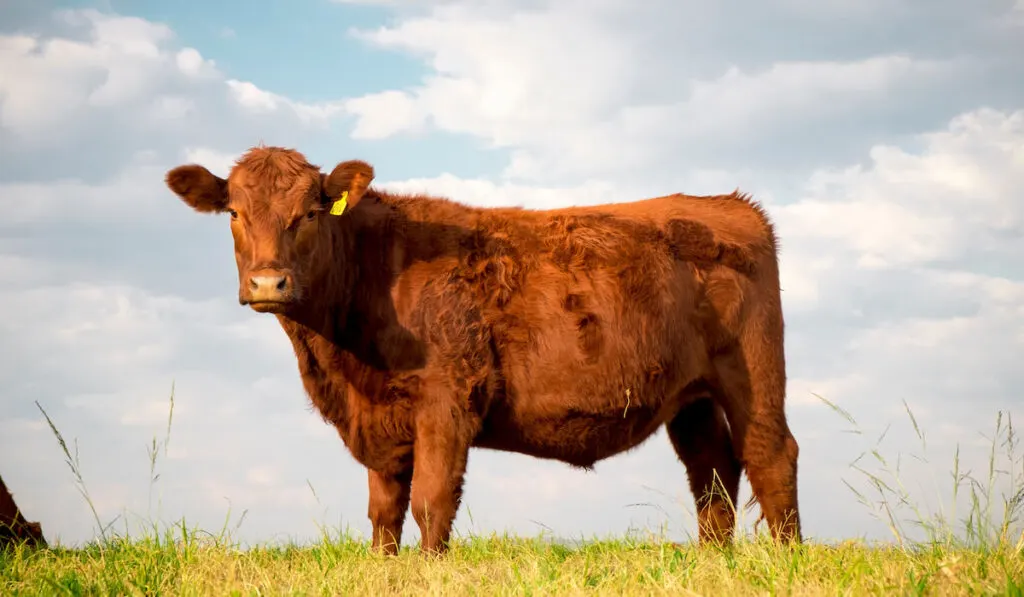
The Beefmaster cow was developed in the early 1930s from a systematic crossing of Shorthorn cows and Hereford cows with Brahman bulls by Tom Lasater. While the exact percentage of the parents is unknown, people believe that Beefmaster is made of 25% Milking Shorthorn, 25% Hereford, and 50% Brahman.
- Origin: This beautiful breed originates from Texas, United States.
- Use: As the name suggests, it is mainly used for beef production.
- Maintenance: It is super easy to maintain and grows very fast.
- Other features: This is a muscular breed, and you can see the large muscles, especially in males.
The Beefmaster breed is the fifth-largest breed in the United States registry. It has many individuals today.
6. Piedmontese
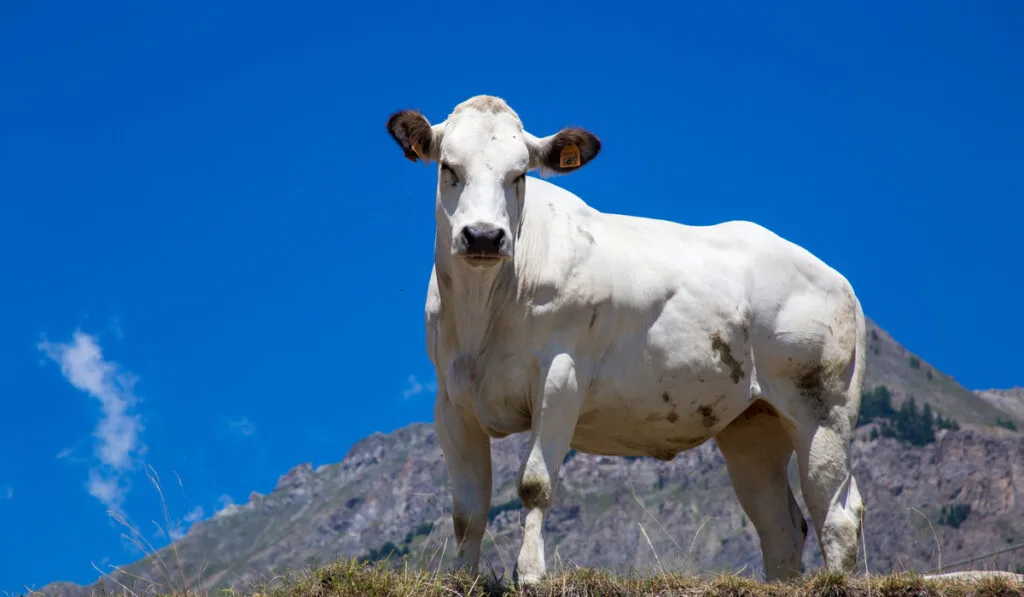
Piedmontese cows are some of the oldest cows on Earth. They originate from Europe as the offspring of Pakistani Zebu and European Auroch.
- Origin: This old cow breed originates from Italy.
- Use: You can raise Piedmontese cows for both milk and meat.
- Maintenance: This breed is super-hardy and disease resistant.
- Other features: It is a muscular breed. It has over 14% higher muscle mass when compared to other cattle breeds.
The Piedmontese breed got introduced into the United States and North America in 1979.
7. Hallikar
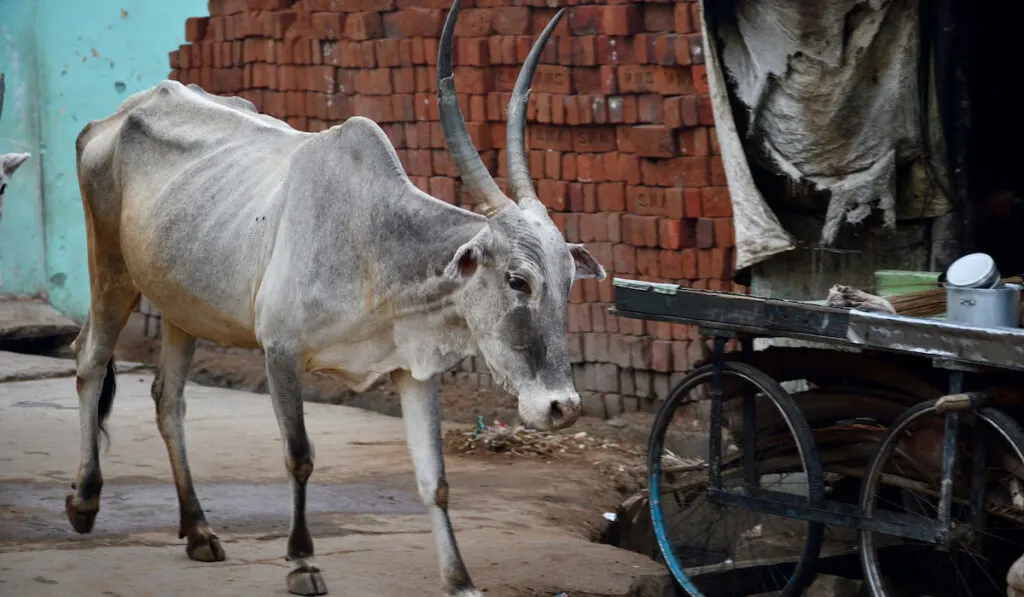
Hallikar cows are muscular, compact, and medium-sized. They have prominent foreheads, strong legs, and long horns. This uncommon breed can be grey or dark grey.
- Origin: Hallikar cows are native to India.
- Use: They are primarily used for beef production and draft.
- Maintenance: As a drought-tolerant breed, the Hallikar can go without water for some days.
- Other features: Hallikar cows are suitable for nomads as they can walk long distances and not get tired quickly.
Hallikars are not as common outside their indigenous India.
8. African Ankole-Watusi (Watusi)
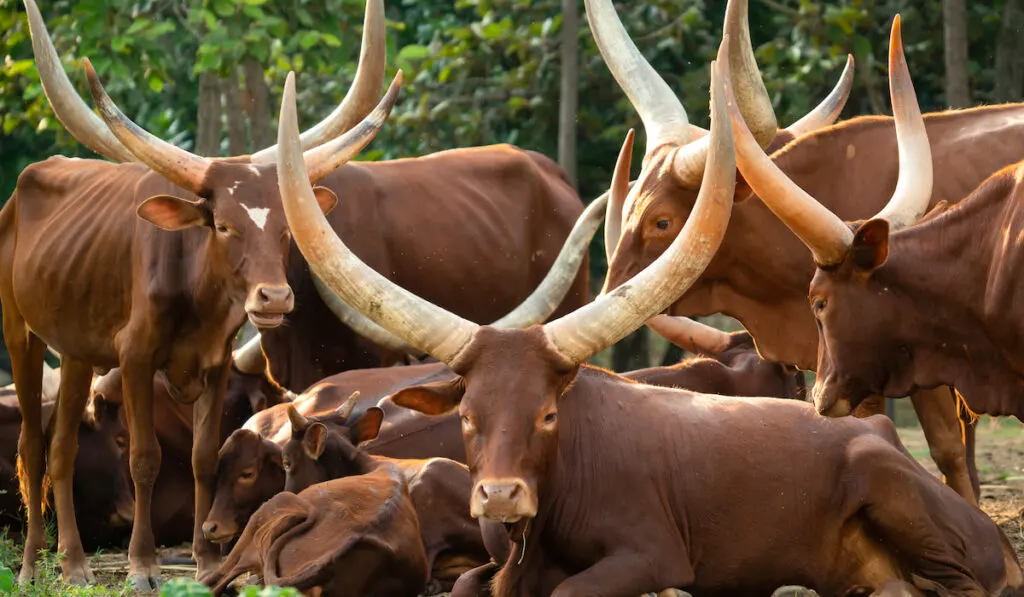
The African Ankole-Watusi cow is a majestic breed that traces its ancestry to more than 6,000 years ago. It was even pictured amongst the Egyptian pyramids.
- Origin: The majestic African Ankole-Watusi breed is native to Africa.
- Use: This beautiful breed’s common (recent) uses are breeding, ornamental, and beef production.
- Maintenance: African Ankole-Watusi cows can tolerate extreme (hot) weather. They are very hardy.
- Other features: This large breed has 12-foot-wide horns that help the individuals to cool their blood, especially in hot places.
The beef of African Ankole-Watusi has low fat and low cholesterol.
9. Randall’s Lineback
The beautiful Randall Lineback cow is an endangered breed from England but is now common in the United States. It is white and black and has short horns and a long tail.
- Origin: It originates from England.
- Use: Randall Lineback cows are mainly used for milk and beef production.
- Maintenance: This is a hardy cow breed, and you can raise it with few problems.
- Other features: Randall Lineback cows are highly intelligent and very docile.
This is an endangered cow breed, so you should raise it (if you can) to help boost its population.
10. Shorthorn (Durham)
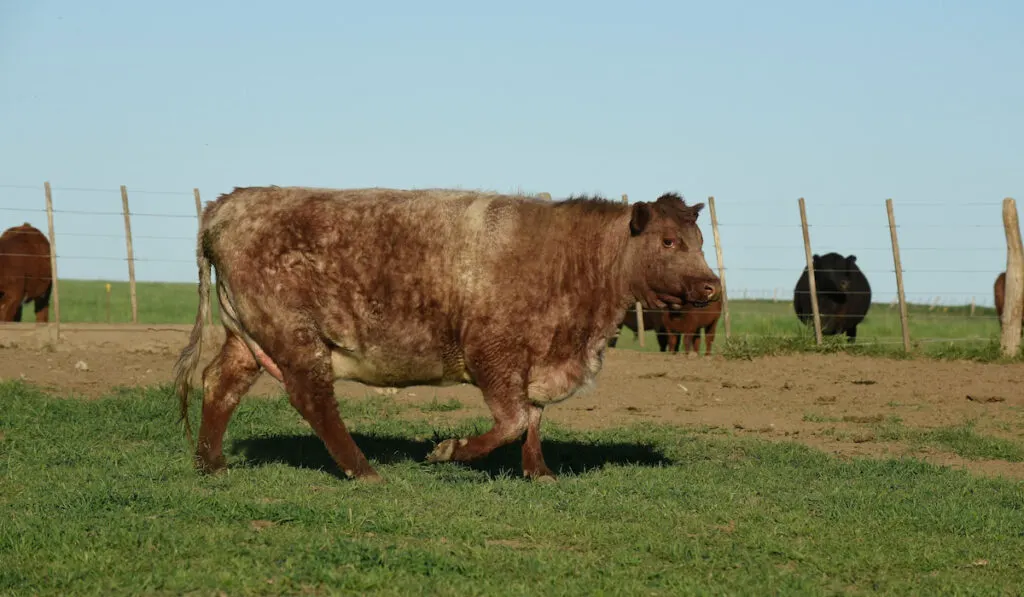
Shorthorn cows were very popular with early settlers because they adapt quickly to temperatures and make great draft cows. They were used in power wagons and to plow lands.
- Origin: They originate from the northeastern coast of England.
- Use: They are all-purpose, as they are used to produce milk and meat. They also make great draft cows.
- Maintenance: With a reasonable feed conversion rate, you do not need to spend as much on your Shorthorn feed.
- Other features: This breed is very adaptable. Individuals can be horned or not and are characterized by their longevity.
Shorthorn cows got introduced into the United States of America in 1783.
11. Dexter
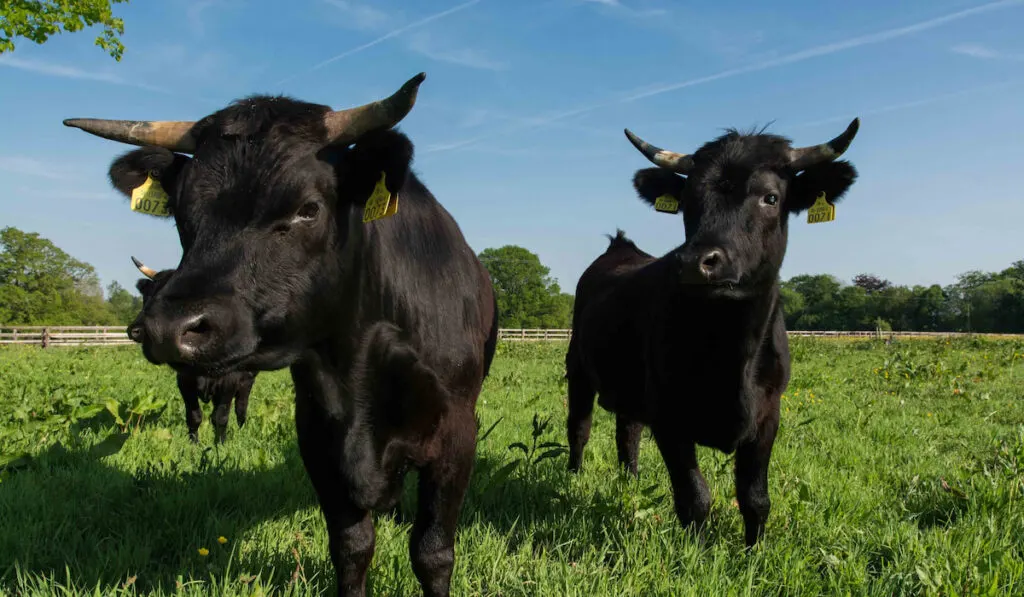
Dexters are one of the smallest breeds in the world. It grows 38-44 inches at the shoulder and can weigh less than 1000 pounds.
- Origin: Dexter cows are native to southern Ireland. They were introduced in the United States in the early 1900s.
- Use: You can use Dexter cows to produce milk and meat.
- Maintenance: Dexter cows require very little pasture due to their size. They can tolerate hot and cold climates.
- Other features: This is a gentle and easy breed. It is characterized by its high rate of fertility.
Dexter cows produce slightly darker red beef.
Which cow breed would you love to see in real life or raise? Continue reading to learn factors that should influence your decision.
What You Should Consider When Selecting a Cow Breed to Raise
Before selecting a cow breed, here are some factors to help you know which breed is suitable for you:
1. The Origin
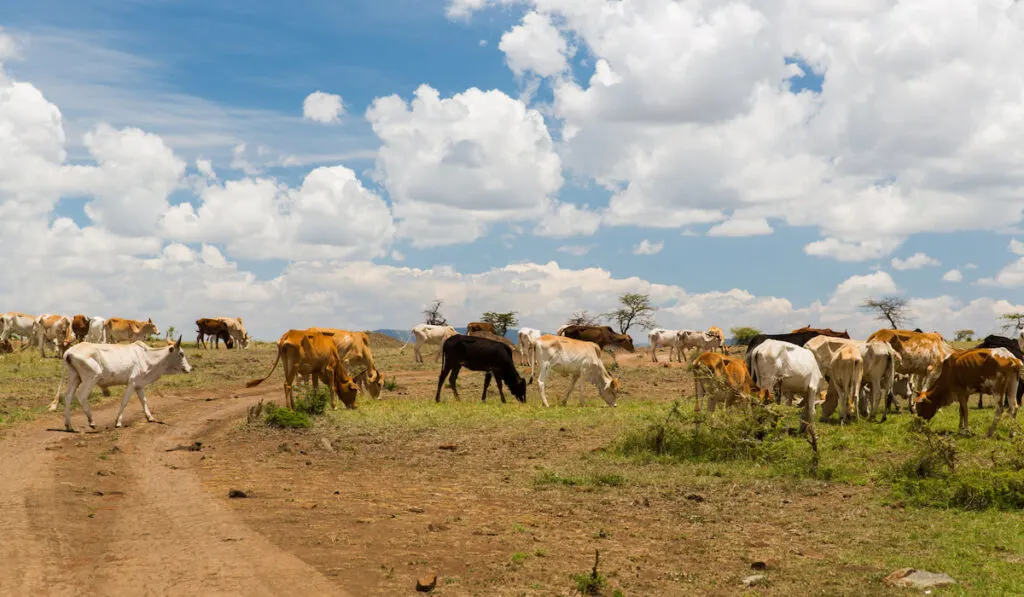
The origin of the cow matters a lot because you can easily trace the breed’s ancestors. The breed’s ancestors can help you identify other important factors, such as temperament and hardiness. Here are familiar places that cattle originate from:
- Europe: European cows are suitable to grow in almost every part of the US because of similar temperatures. Many US cow breeds are descendants of European breeds.
- Asia: Asian breeds are large, and they are primarily raised in the southern states of the US because they tolerate (and prefer) warmer temperatures.
- Africa: African cows are similar to their Asian cousins in size and temperature preference. However, they appear to be hardier.
Try to find out the origin of a breed before you start raising it.
2. Uses of the Breed
Why are you buying the cow? That is, what do you want to use it for? The reason why you want to buy a cow determines the type of breed that you should buy.
If you are looking for a pet, you should go for the most docile breeds. As for beef, however, you want to go for breeds that grow quickly with abundant muscling. Here are some typical cow uses:
- Milk: Even though every cow (female) produces milk, dairy cows are best for milk production as they produce more than enough. You can get sweet cheese and cream from the milk of these cows.
- Beef: Beef is the meat of cows. Suppose beef is what you want; select breeds that grow big and heavy. Also, consider the quality of the beef you want to select a suitable breed.
- Work: Drafting or working cows are breeds used in farms and other places to plow and do other farm work. Machines have mostly replaced draft animals, and drafting is frowned upon due to anti-animal labor laws and activism.
- Ornamental: Ornamental or showy cows are the most beautiful. While they can have other uses, their primary use is to tell a story of their beauty or past.
- Pet: Pet cows are small or dwarf breeds of cows that you can grow at home. They are mostly docile. Even though they are pets, they can have other uses, especially when they are mature enough.
What do you want to use your cow for?
3. Nutritional Requirements
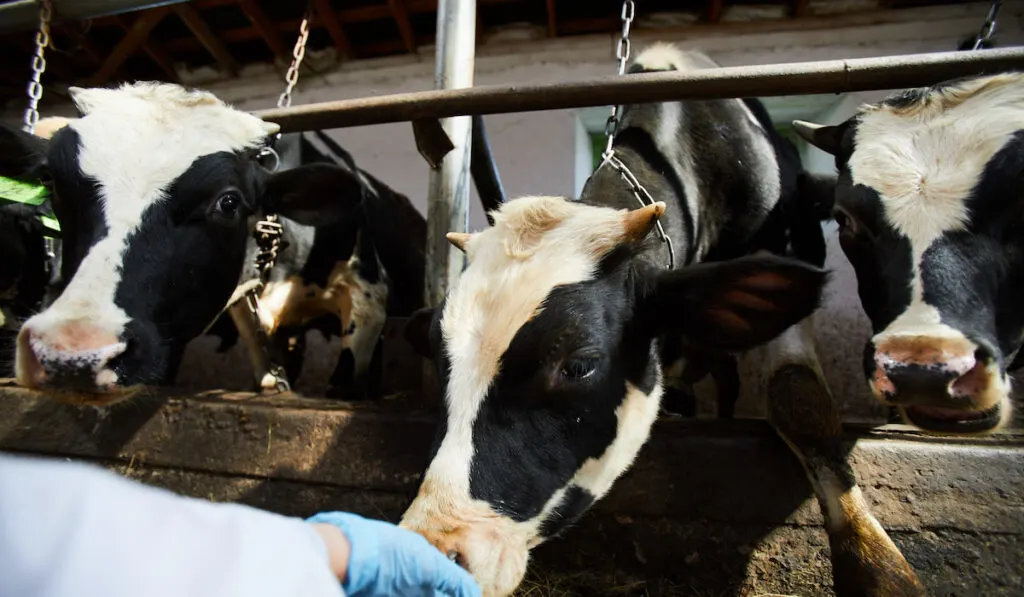
The feed or nutritional requirements of a cow breed determine how quickly it can grow and how easily you can grow it. Some breeds may be beautiful, but they have proven to be difficult to raise. This is why you must select breeds that you can raise with ease.
Here are some factors to consider regarding the nutrition of a cow breed:
- Size: The size of the breed matters a lot because the larger the breed, the more food it will consume. If you do not have a large grazing field or enough money to buy hay and grains, you should go for smaller breeds.
- Age: Younger cows need more proteins though they eat less than older cows. This means that you may need to supplement the feed of younger cows. However, some cattle breeds, especially the hardy ones from Africa, will grow fine without supplements.
- Growth phase: Pregnant or lactating cows need as much protein as possible.
- Season and temperature: The season influences the temperature. Temperature affects cows’ nutrition because cows in cold places require more grains to help them keep warm. If you live in cold regions, go for double-coat breeds.
If you do not select the right breed regarding their nutritional requirement, you may face some challenges when growing the cows sooner or later.
4. Temperament and Behaviors
The behavior of any cow that you want to buy matters a lot. If the cows are very docile, you can keep them as pets. Higher strung or more aggressive breeds should be kept so they cannot hurt people. The behavior of cows depends on the breed and how they are raised.
Here are some factors that you must know regarding the temperament of a specific cow breed:
- Parent breeds: If the breed was developed from other breeds, research the parent breeds for some insight into the cross-bred variety.
- News: Please read news and reports on the cow breed. Are they known for not tolerating humans?
- Companion animals: If a cow breed has a hot temperament, are there companion animals (such as goats or sheep) that you can easily raise with it? Are your farm animals safe?
Doing this research before raising the breed is best for your safety.
5. Other Information about the Breed
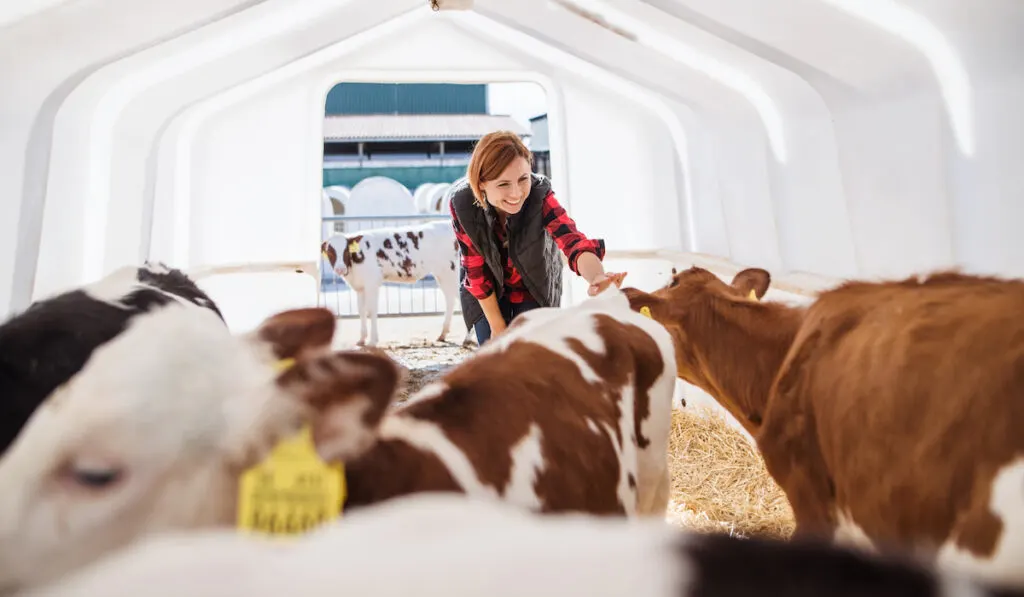
The other factors mentioned above are necessary for you to know. Other factors can influence your decision as they are personal to you. For example, do you have color preferences? Here are some factors that you can consider:
- Colors: Some cows are white, grey, or black. Others are red or brown. Some are spotted, while others have a color belt. The color and design of the breed make it beautiful, so you want to go for breeds that you love their appearance, especially if you want to raise them as pets.
- Horns: Will a cow breed grow horns or not? Even though a cow is docile, the presence of horns can scare people away from it. The possession of horns in cows is worth considering.
Remember that the choice is still left to you.
After considering every factor, which cow breed do you think is the most suitable for you?
Conclusion
As you can see, there are many types of cow breeds. Even though they are all cows, these breeds have their own uses and characteristics. Using the helpful guide in this article, choose the most suitable cow breed for your farm.
Resources
- https://www.agdaily.com/livestock/top-10-cattle-breeds-united-states/
- https://petkeen.com/most-popular-cattle-breeds-us/
- https://www.agriculture.com/family/living-the-country-life/16-common-cattle-breeds
- https://www.livestocking.net/list-cattle-breeds#List_of_Cattle_Breeds
- https://agritech.tnau.ac.in/expert_system/cattlebuffalo/Breeds/l
